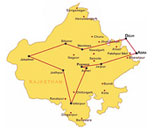Rajasthan Food
The finest cuisine in India was derived from the Mughals and, along with European cooking, influenced the royal kitchens of India.But in Rajasthan the common man's kitchen remained untouched. Rajasthani cooking was influenced by the war -like lifestyle of its inhabitants and the availability of ingredients in this region.
Cooking here in Rajasthan has its own unique flavour and the simplest ingredients go into preparing most dishes. Scarcity of water and fresh green vegetables have had their impact on the cooking in the desert areas of Jaisalmer, Bikaner and Barmer. Instead of water the women prefer to use milk, buttermilk and clarified butter. Dried lentils and beans from indigenous plants are used liberally. Gram flour is a major ingredient and is used to make delicacies like 'khata', 'ghatta ki sabzi' and 'pakodi'. Bajra and corn, the staple grains, are used to make rotis, 'rabdi' and 'kheechdi'; and various chutneys are made from locally available spices like turmeric, coriander, mint and garlic.
Eating Habits
The personal preferences of the people about food are very much varied. The Rajput warrior was not averse to hunting, killing game to put in his pot at night. The Vaishnavas, followers of Krishna, were vegetarian, and strictly so, as were the Bishnois, a community known for their passion to conserve both animal and plant life. Even among Rajputs, there were enough royal kitchens where nothing other than vegetarian meals were cooked.
The Marwaris of course, were vegetarian too, but their cuisine, though not too different from the Rajputs, was richer in its method of preparation. And then there were the Jains too, who were not only vegetarians, but also the ones who would not eat after sundown, and whose food had to be devoid of garlic and onions which were, otherwise, important ingredients in the Rajasthani pot.
Main Dishes
Gram flour is a major ingredient here and is used to make some of the delicacies like Khata, Gatte Ki Sabzi and Pakodi. Powdered lentils are used for Mangodi and Papad. Bajra and corn are used all over the state for preparations of Rabdi, Khichdi and Rotis.
A soup of legumes, flavoured with red chilli peppers, yoghurt or milk and sometimes a vegetable such as Okra, Jackfruit, Eggplant, Mustard or Fenugreek leaf. The wealthy can afford to eat meat regularly, but many abstain for religious reasons. Though the Rajasthani kitchen was able to create much from little, it had also to cater to different communities with their own ritual observances.
Chutneys Galore
Various chutneys are made from locally available spices like turmeric, coriander, mint and garlic. Perhaps the best-known Rajasthani food is the combination of dalbati and churma but for the adventurous traveller, willing to experiment, there is a lot of variety available.
Chapatti Making
The chapatti is a flat, unleavened bread which serves almost as a spoon, for it is used as a scoop to transfer food to the mouth. It complements both the texture and flavor of the food it scoops up, absorbing runny sauces, balancing strong flavors and smoothness.
Frying Puris
Puris are delicious, fried wheat bubbles which have varied uses; as snacks, scoops for food and as a complement to hot spices. Family members typically sit on the floor and are served piping hot food by the lady of the houses.
Khud khargosh
Khud Khasrgosh (Hare or rabbit meat cooked in a pit) is a Rajput specialty during summer, when the hare is lean. The hare is skinned and stuffed with spices, wrapped in dough and finally in layers of mud-soaked cloth. The ambrosial result is meat perfectly blended with the spices and dough.
The Indian Kitchen - The simple Indian Kitchen has a brick-and-mud fireplace. Food is usually cooked over a wood or charcoal fire,in clay,brass,or copper utensils.
Lassi
Natural yogurt is churned to remove the butter content for the making of Lassi or buttermilk a cooling summer beverage.
Local Food
'Dal-baati'(dumplings with a filling, roasted among hot coals) and 'choorma'(dry, flaky, sweet crumb pudding) are the universal favourites. The non-vegetarian dishes include 'soola' or barbecued meats, marinated with a local vegetable. But it is the sweets that the Rajasthanis freak out on. Each part of the State has its own speciality - so Jodhpur and Jaisalmer are famous for their 'laddoos', Pushkar for its 'malpuas', Bikaner for its 'rasgullas', Udaipur for its 'dil jani', Jaipur for its 'mishri mawa' and 'ghevar', Ajmer for its 'sohan halwa'; and mouth watering 'jalebis' can be found in all cities. It is difficult to explain the merits of each of these sweets, so whichever city you are in just ask for the local speciality and enjoy it. Most hotels have excellent restaurants that serve a selection of Rajasthani dishes as well as international favourites.
Delectable Desserts
Besides spicy flavours, each region is distinguished by its popular sweets. Most people from Rajasthan have a natural liking for sweets or 'Mithai' as it is locally called. People residing in Rajasthan prefer 'Jalebis' and 'Fafda' with a large glass of hot milk in the morning.
Each region has its own specialty. Laddoos from Jodhpur and Jaisalmer, Malpuas from Pushkar, Jalebies from most big cities, Rasogullas from Bikaner, Dil Jani from Udaipur, Mishri Mawa and Ghevar from Jaipur, Mawa Katchori from Jodhpur, Sohan Halwa from Ajmer, Mawa from Alwar, the list is unending.

